
The Cybersecurity and Infrastructure Security Agency (CISA) has issued a warning about a significant vulnerability in Microsoft Windows, tracked as CVE-2018-8639. This flaw is present in the Win32k component, a critical Windows driver responsible for managing graphical user interface (GUI) interactions. Exploiting this vulnerability allows attackers to escalate privileges and execute arbitrary code in kernel mode, which can bypass security protocols and potentially install malware or manipulate system functions undetected. Despite being patched by Microsoft in December 2018, the vulnerability continues to pose a risk, especially for systems that have not been updated, such as legacy systems in industrial control or healthcare infrastructures.
CISA added CVE-2018-8639 to its Known Exploited Vulnerabilities (KEV) catalog, highlighting its persistent threat to both public and private sector networks.
The flaw is classified as an improper resource shutdown or release (CWE-404), allowing authenticated local attackers to improperly release system resources, opening the door for privilege escalation. Once the vulnerability is exploited, attackers gain kernel-mode execution rights, which could lead to undetected installation of persistent malware, making it difficult to trace the attackers’ actions.
The exploit often begins with phishing campaigns or credential theft, complicating detection efforts.
CISA’s advisory mandates that federal agencies must immediately apply the Microsoft patch for this vulnerability or take steps to discontinue affected systems if patching is not feasible. While the directive is not legally binding for the private sector, CISA strongly encourages compliance to minimize supply chain risks. The agency recommends implementing layered defense strategies, including network segmentation, adhering to the principle of least privilege, and continuous monitoring for suspicious kernel-mode activity. These steps are vital for mitigating the risks associated with the vulnerability, as it provides an attack vector for highly skilled threat actors, including groups like APT29 and Lazarus Group, which specialize in espionage and data exfiltration.
Organizations reliant on legacy systems face particular challenges when applying the patch, as it may disrupt compatibility with specialized software. In such cases, CISA advises virtual patching techniques using intrusion detection systems (IDS) or endpoint detection and response (EDR) tools to detect exploit attempts. Additionally, the agency suggests adopting zero-trust architectures and conducting routine kernel-mode integrity checks as proactive measures to secure systems. The ongoing threat from this vulnerability, especially within industries relying on outdated systems, underscores the critical need for timely updates and comprehensive cybersecurity strategies.
Reference:
The post CISA Warns of Exploited Windows Win32k Flaw first appeared on CyberMaterial.


